Effect of injection timing and mixing rate of water in jatropha emulsion on combustion and performance of di diesel Engine
The current paper studies the effect of the injection timing and Jatropha water emulsion (JWE)
with different mixing ratios on the combustion and performance characteristics of a direct injection
diesel engine. The experimental study was carried out using a four-stroke, high speed, small capacity,
direct-injection diesel engine. The engine ran on the Light oil (LO) and neat Jatropha oil (JO) for
baseline data. In this study, Jatropha emulsion was made by mixing mass ratios of 10% and 20% of
water so called JWE10%, and JWE20%, respectively. While changing fuels from LO to JO, JWE10%,
and JWE20%, we tested the engine with various injection timings of 17, 20, and 23 degree crank angle
before top dead center (o BTDC). The acquired data was analyzed for various combustion parameters
such as in-cylinder pressure, heat release rate (HRR), ignition delay (ID); for performance parameters
such as exhaust gas temperature and brake thermal efficiency (BTE). At the original injection timing,
the peak of in-cylinder pressure, and the HRR reduced, and they marginally increased when advancing
the injection timing in comparison with those of the Jatropha oil at original injection timing. Ignition
delay increased with an increase of the injection timing for both emulsion fuels. When advancing the
injection timing to 23o BTDC, the emulsion fuels reduced exhaust gas temperature. BTE increased when
using emulsion fuels, particularly the JWE10%. Overall, the optimum water mixing rate was 10%, while
the optimum injection timing was 20o BTDC
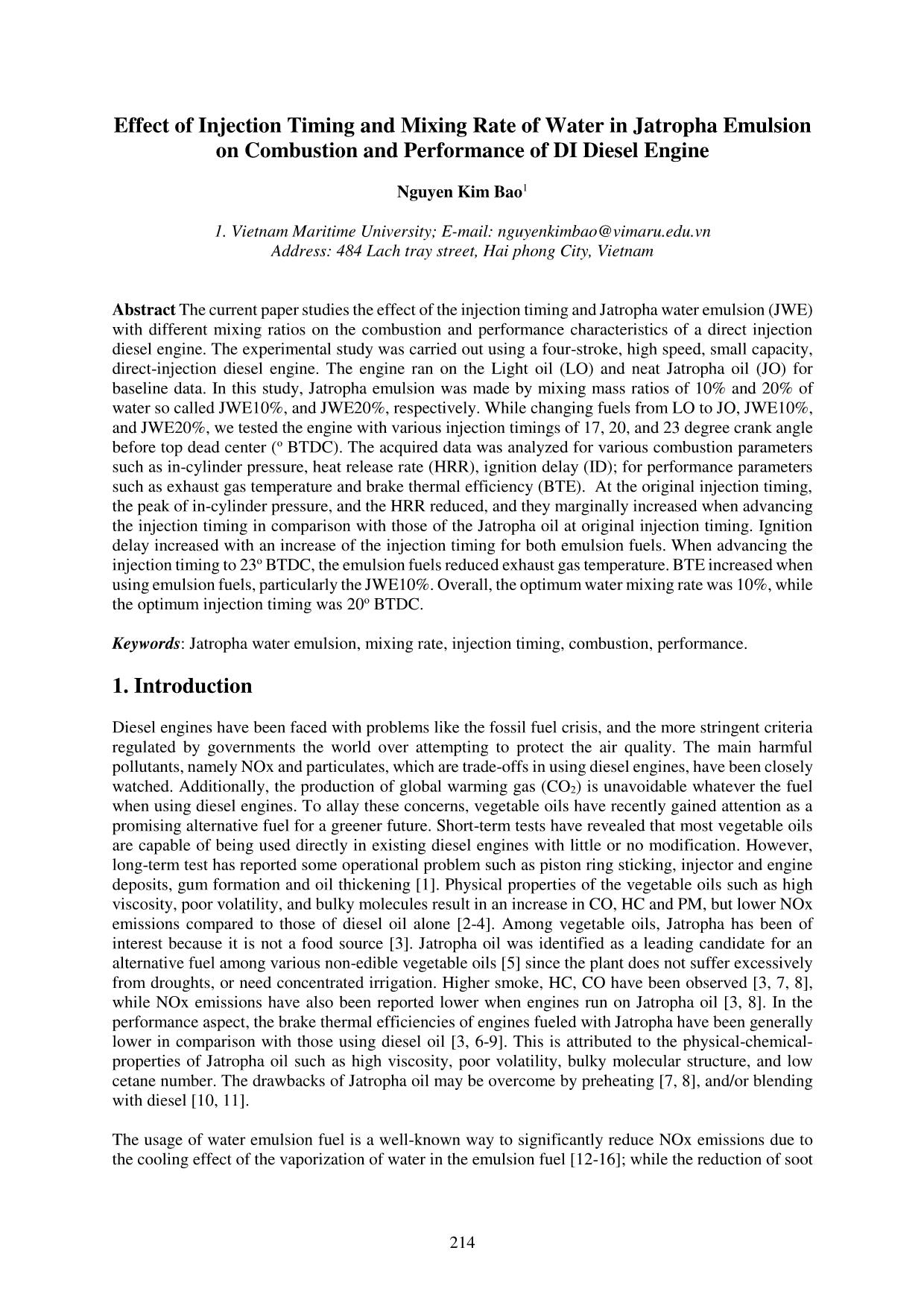
Trang 1
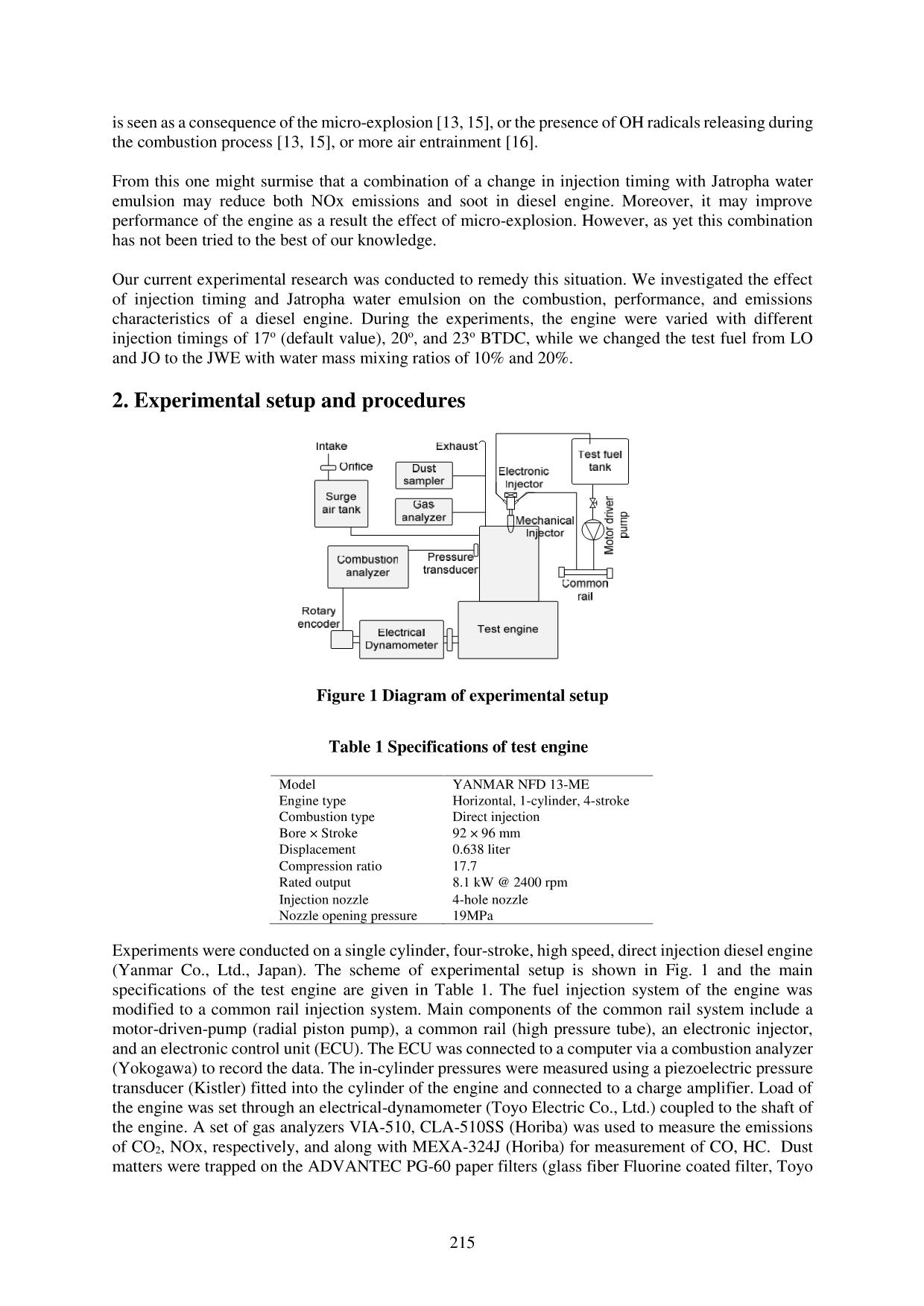
Trang 2
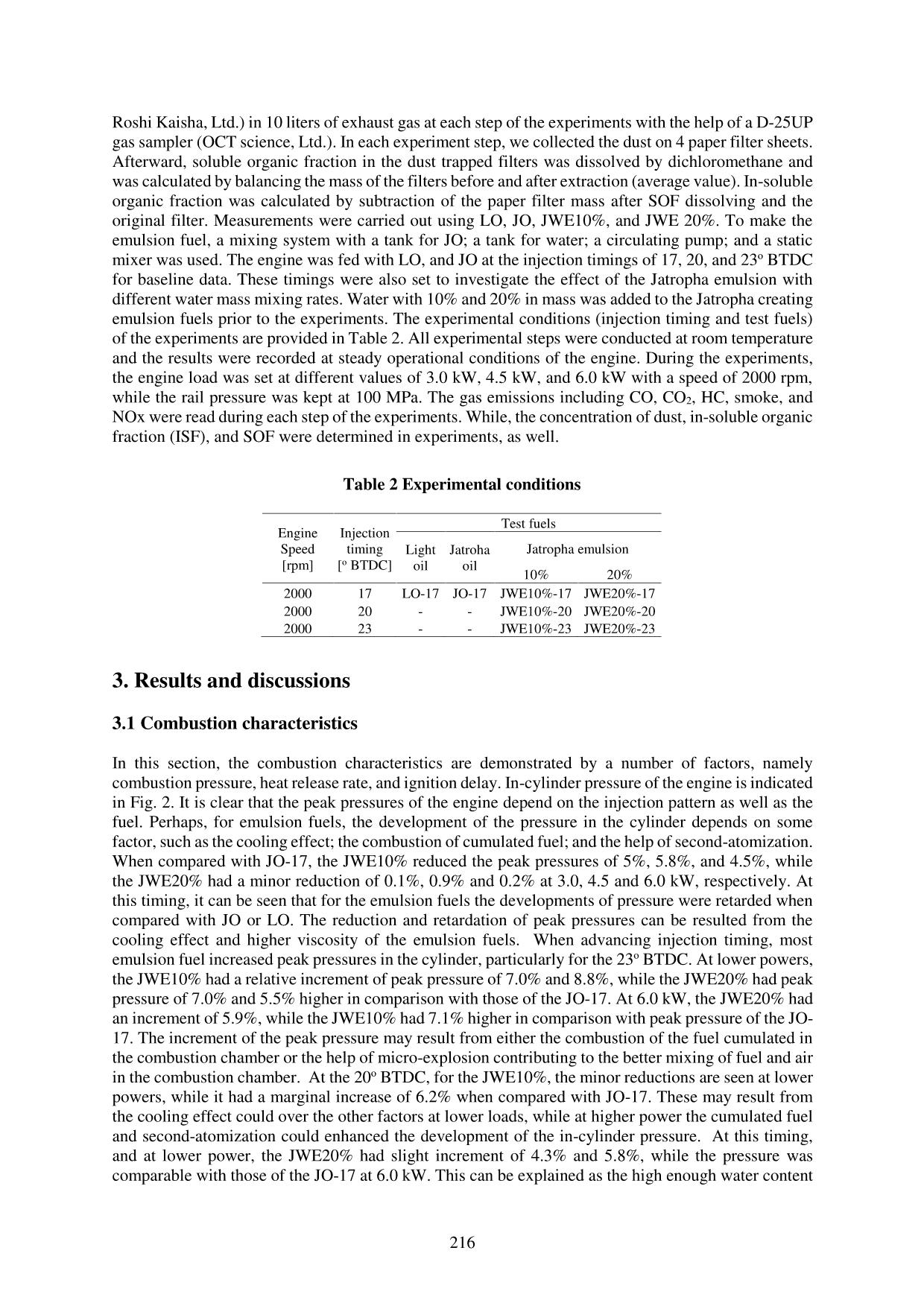
Trang 3
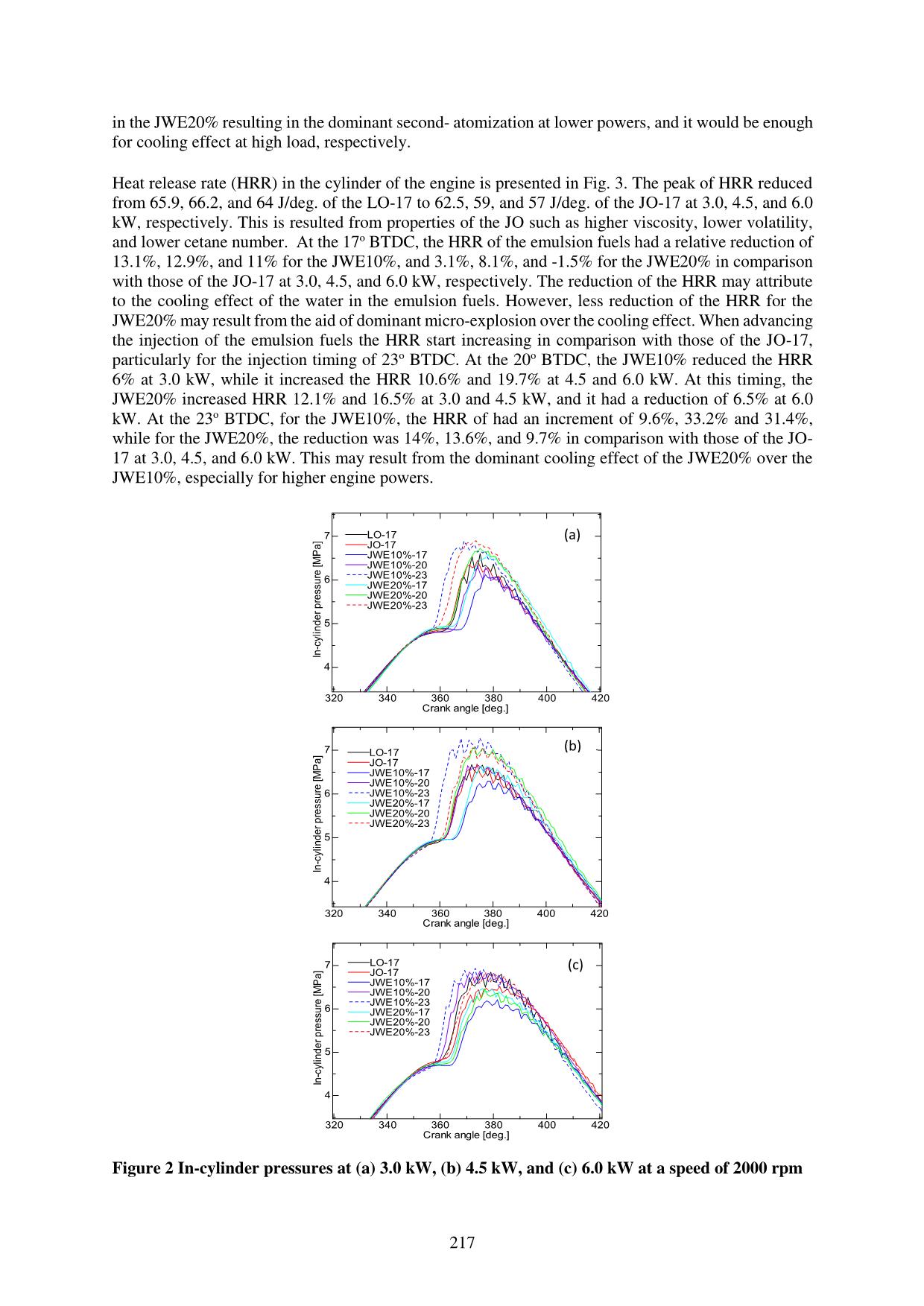
Trang 4
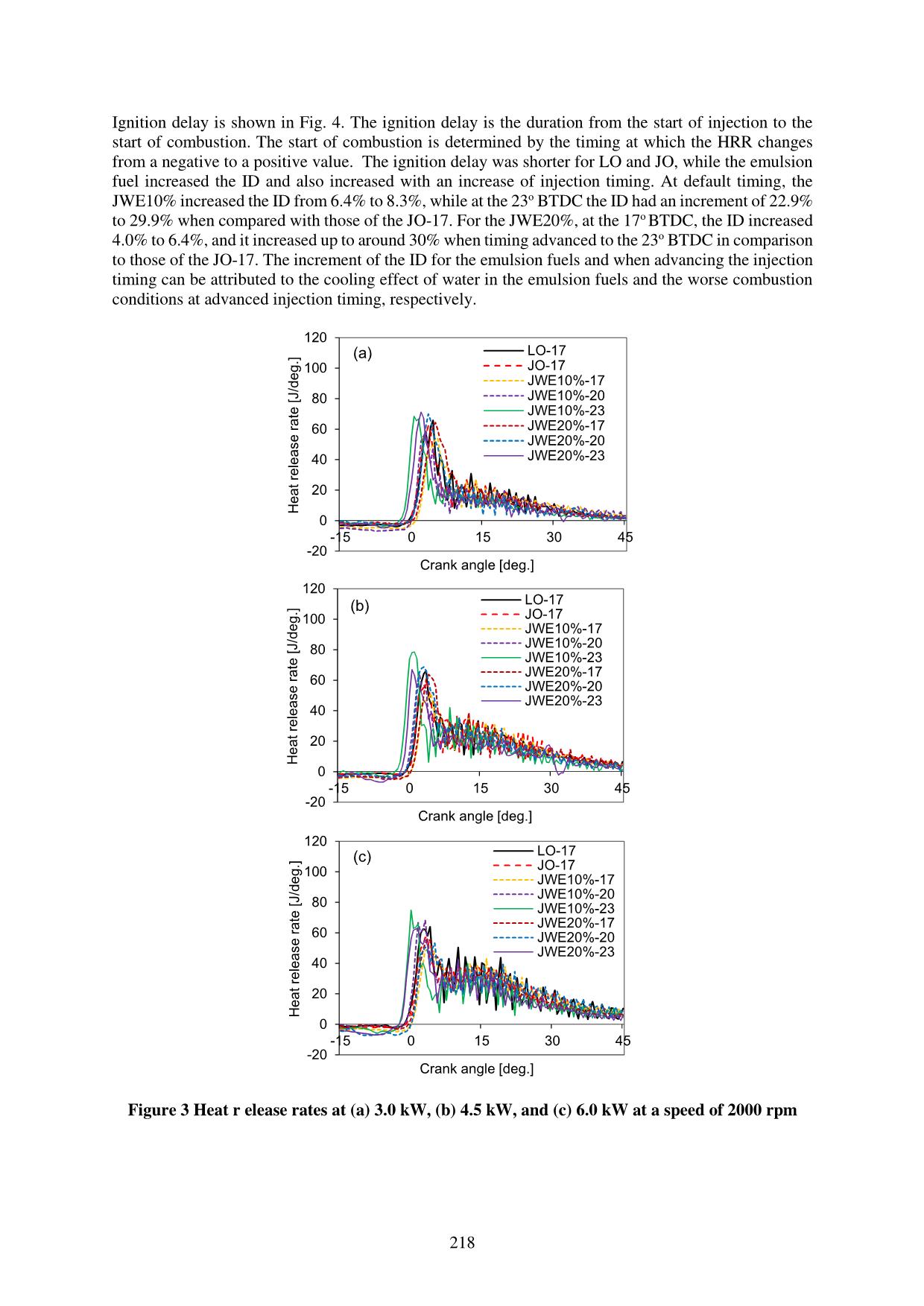
Trang 5
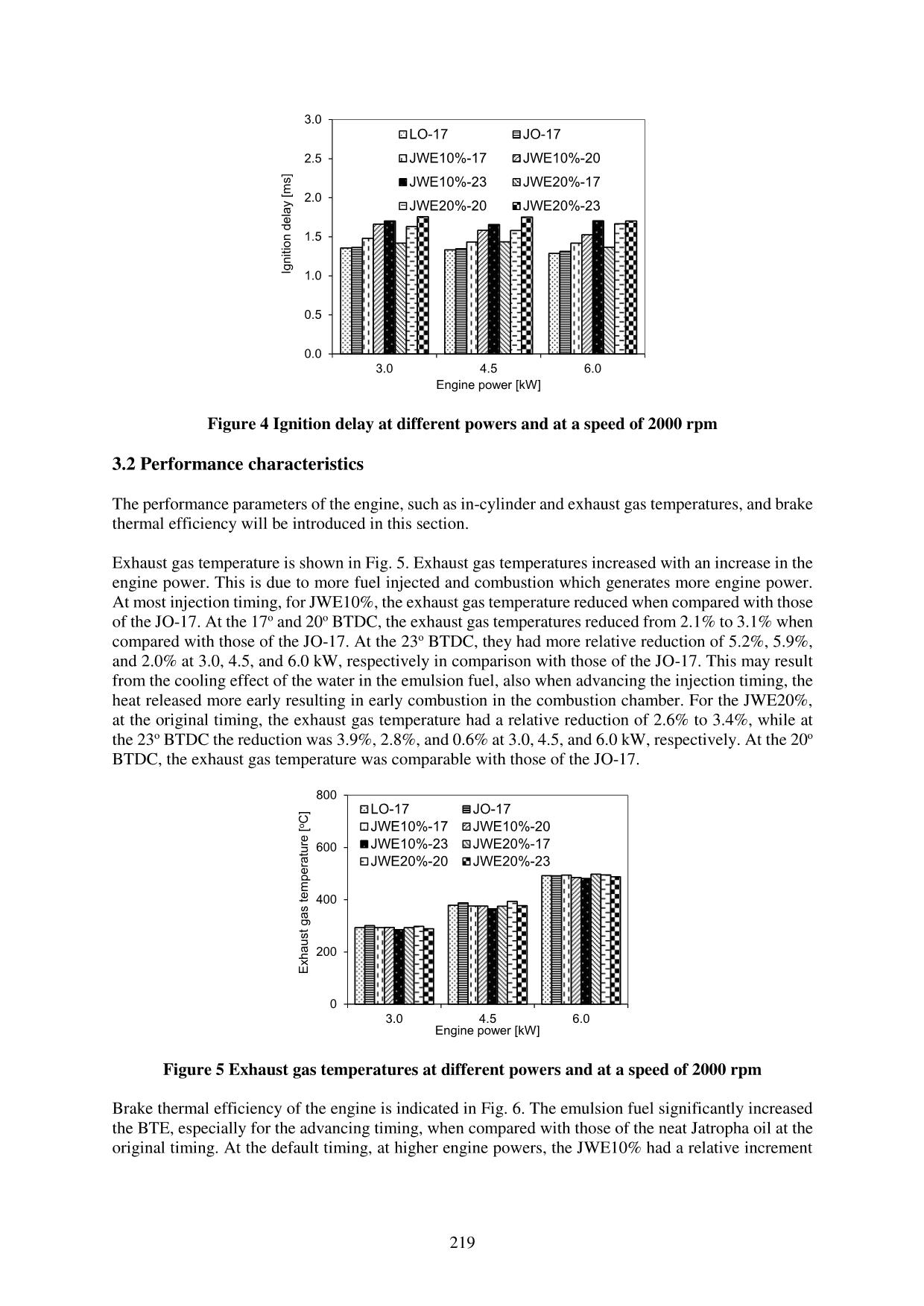
Trang 6
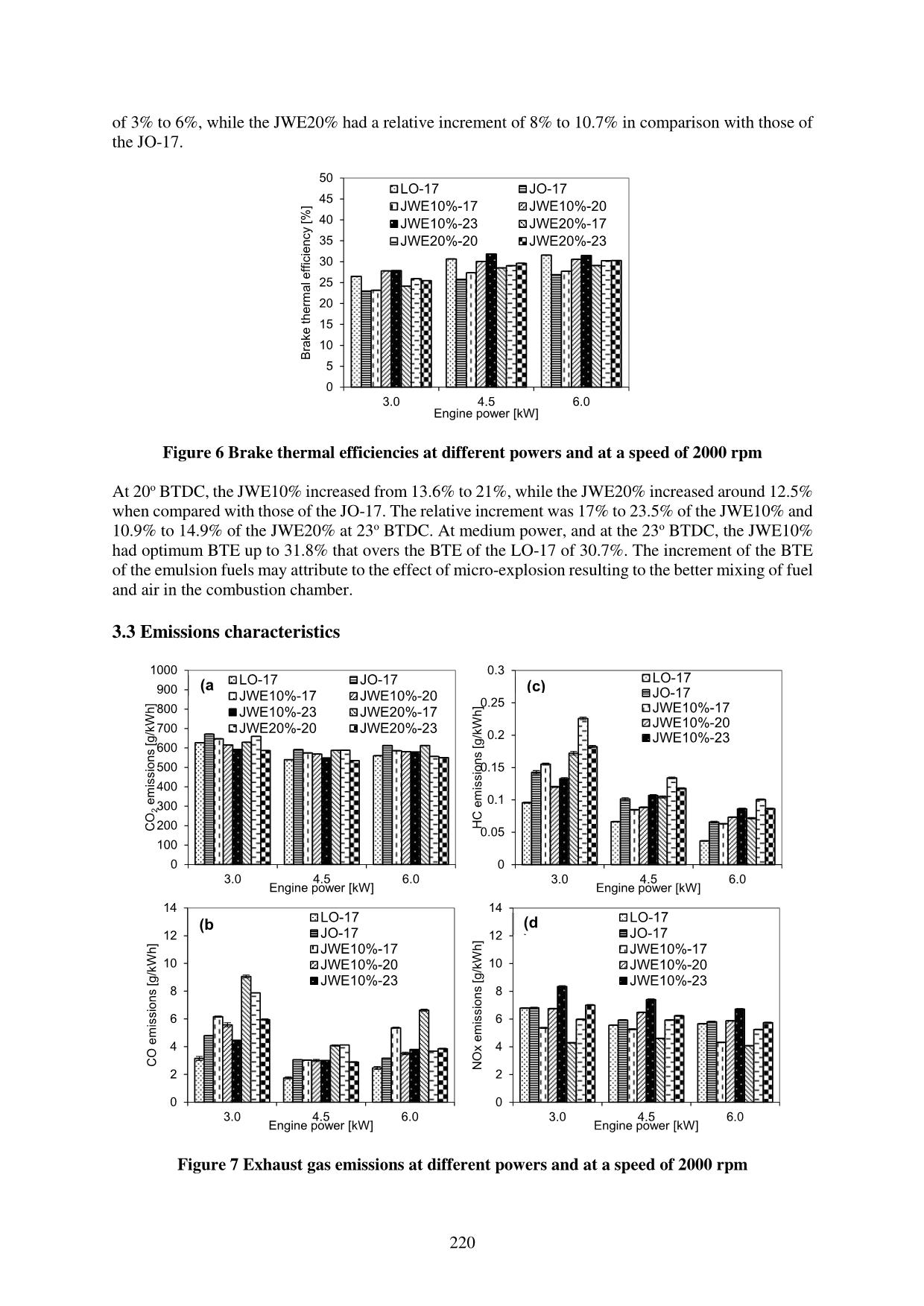
Trang 7
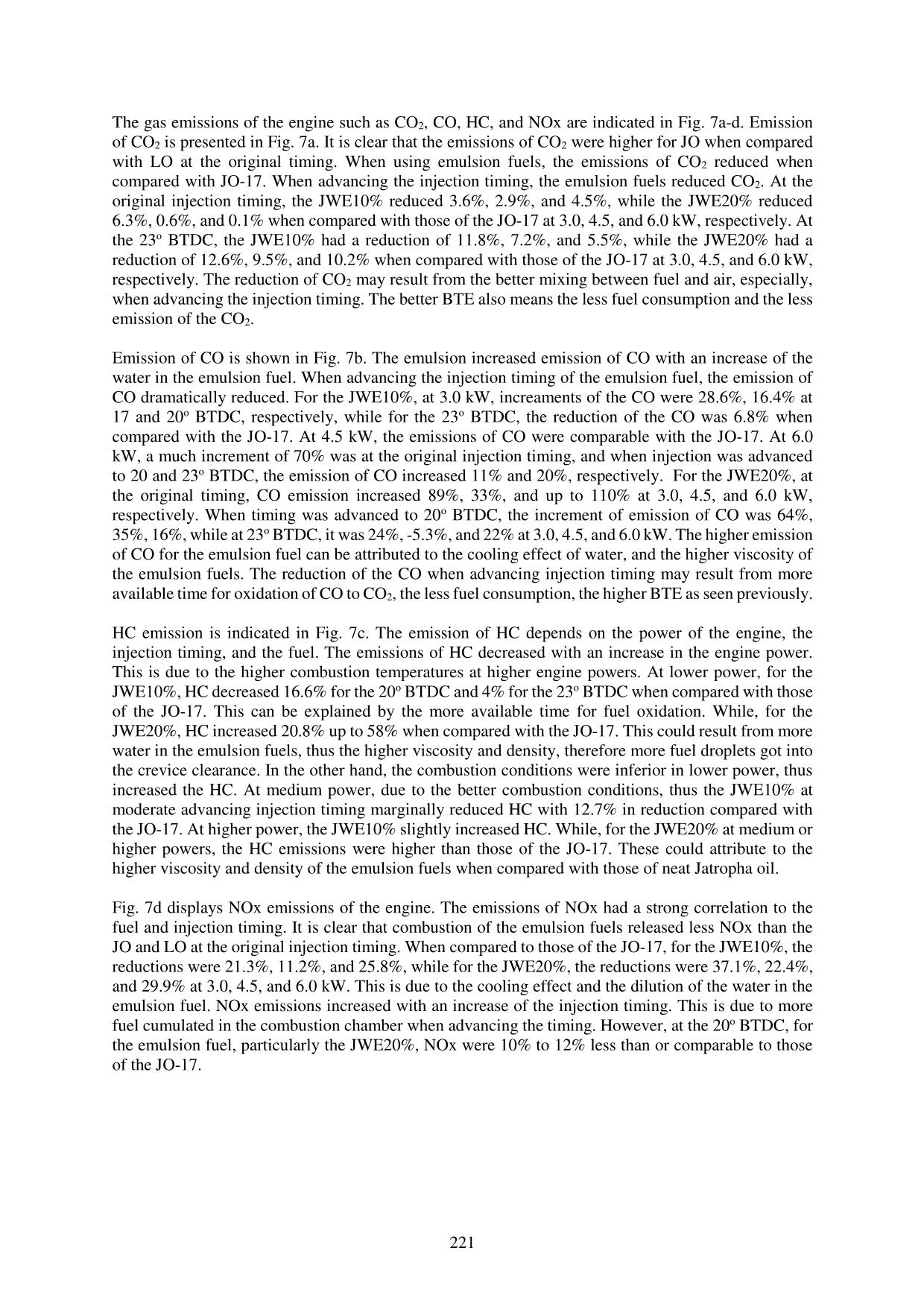
Trang 8
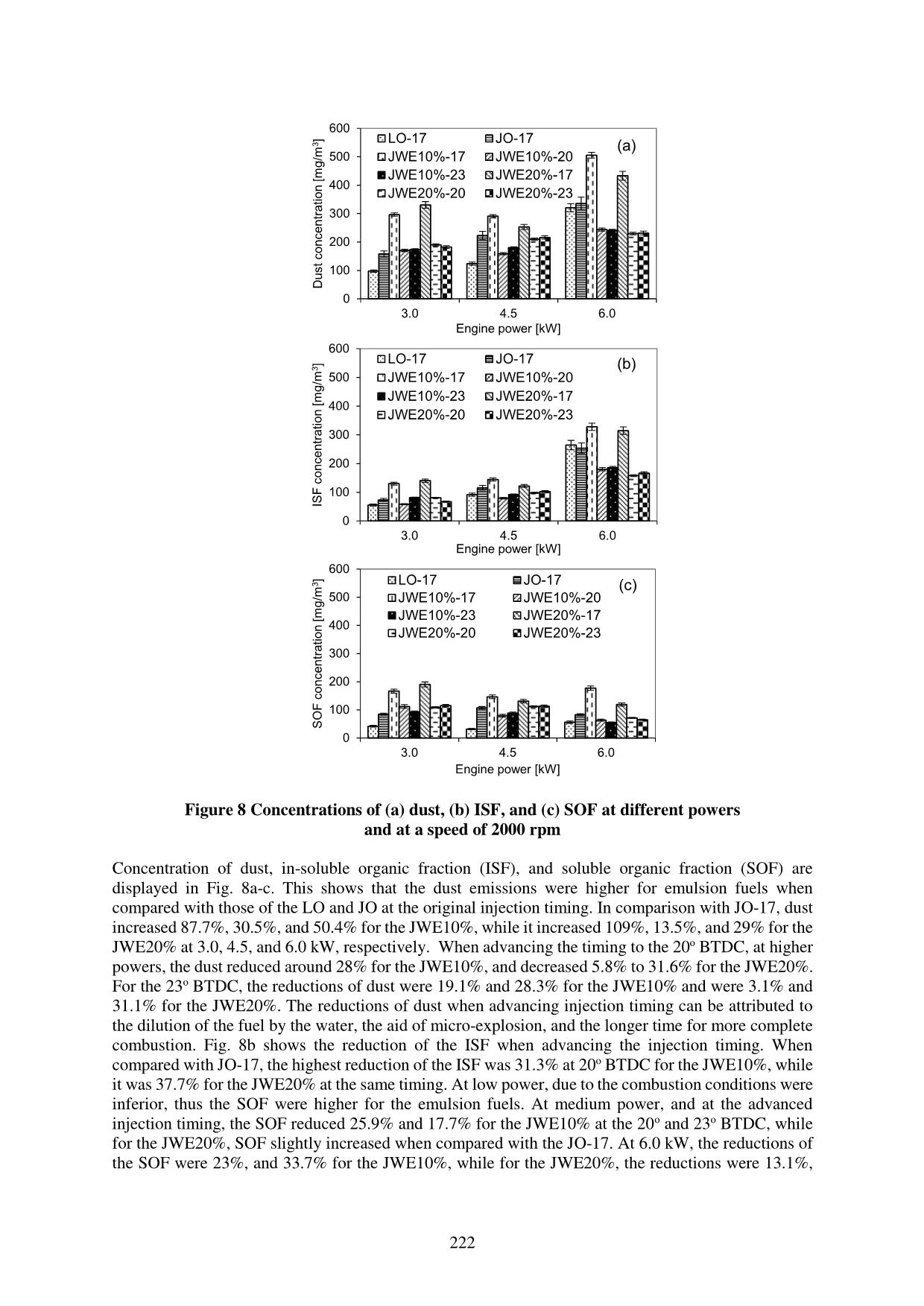
Trang 9
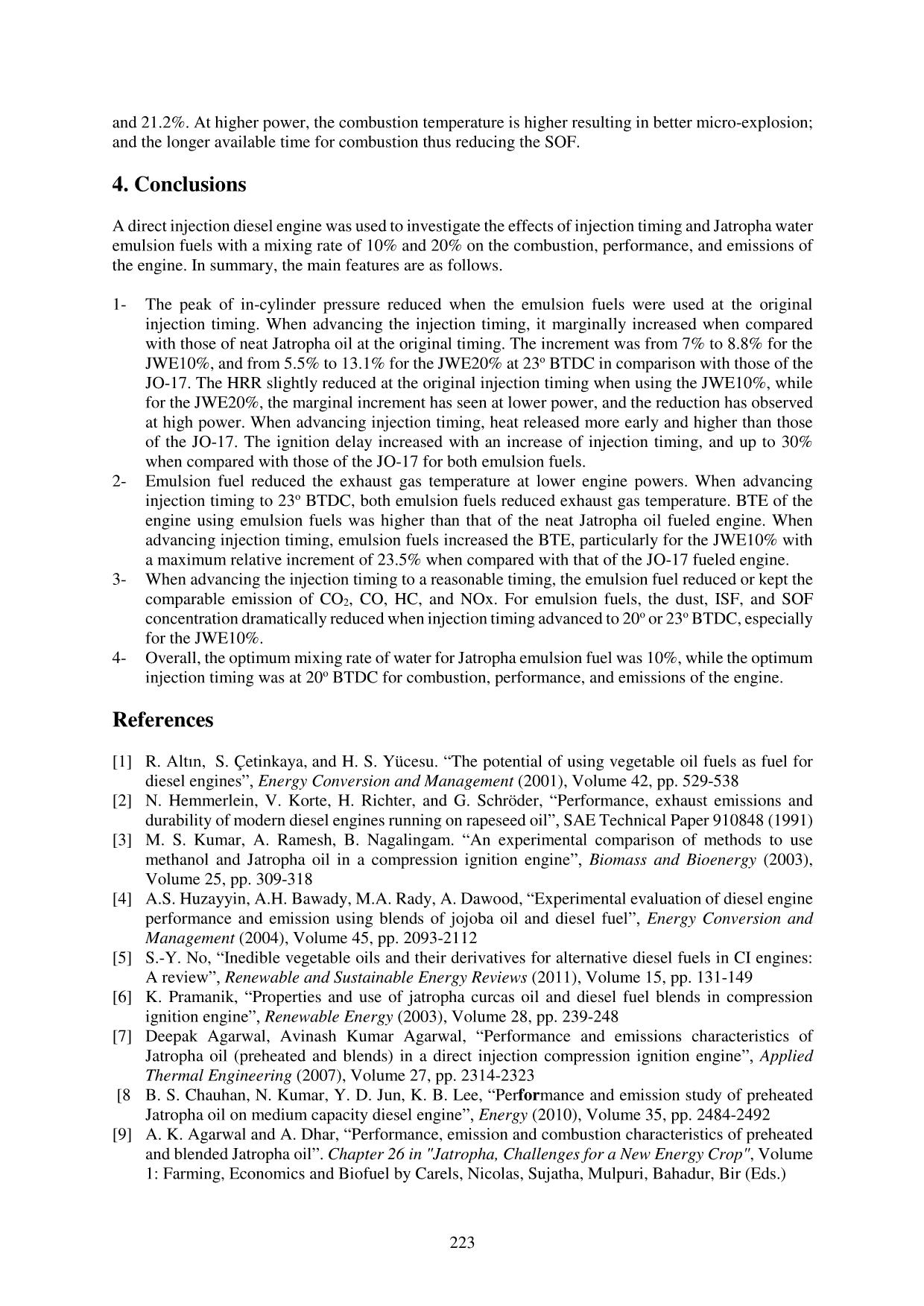
Trang 10
Tải về để xem bản đầy đủ
Tóm tắt nội dung tài liệu: Effect of injection timing and mixing rate of water in jatropha emulsion on combustion and performance of di diesel Engine

214 Effect of Injection Timing and Mixing Rate of Water in Jatropha Emulsion on Combustion and Performance of DI Diesel Engine Nguyen Kim Bao1 1. Vietnam Maritime University; E-mail: nguyenkimbao@vimaru.edu.vn Address: 484 Lach tray street, Hai phong City, Vietnam Abstract The current paper studies the effect of the injection timing and Jatropha water emulsion (JWE) with different mixing ratios on the combustion and performance characteristics of a direct injection diesel engine. The experimental study was carried out using a four-stroke, high speed, small capacity, direct-injection diesel engine. The engine ran on the Light oil (LO) and neat Jatropha oil (JO) for baseline data. In this study, Jatropha emulsion was made by mixing mass ratios of 10% and 20% of water so called JWE10%, and JWE20%, respectively. While changing fuels from LO to JO, JWE10%, and JWE20%, we tested the engine with various injection timings of 17, 20, and 23 degree crank angle before top dead center (o BTDC). The acquired data was analyzed for various combustion parameters such as in-cylinder pressure, heat release rate (HRR), ignition delay (ID); for performance parameters such as exhaust gas temperature and brake thermal efficiency (BTE). At the original injection timing, the peak of in-cylinder pressure, and the HRR reduced, and they marginally increased when advancing the injection timing in comparison with those of the Jatropha oil at original injection timing. Ignition delay increased with an increase of the injection timing for both emulsion fuels. When advancing the injection timing to 23o BTDC, the emulsion fuels reduced exhaust gas temperature. BTE increased when using emulsion fuels, particularly the JWE10%. Overall, the optimum water mixing rate was 10%, while the optimum injection timing was 20o BTDC. Keywords: Jatropha water emulsion, mixing rate, injection timing, combustion, performance. 1. Introduction Diesel engines have been faced with problems like the fossil fuel crisis, and the more stringent criteria regulated by governments the world over attempting to protect the air quality. The main harmful pollutants, namely NOx and particulates, which are trade-offs in using diesel engines, have been closely watched. Additionally, the production of global warming gas (CO2) is unavoidable whatever the fuel when using diesel engines. To allay these concerns, vegetable oils have recently gained attention as a promising alternative fuel for a greener future. Short-term tests have revealed that most vegetable oils are capable of being used directly in existing diesel engines with little or no modification. However, long-term test has reported some operational problem such as piston ring sticking, injector and engine deposits, gum formation and oil thickening [1]. Physical properties of the vegetable oils such as high viscosity, poor volatility, and bulky molecules result in an increase in CO, HC and PM, but lower NOx emissions compared to those of diesel oil alone [2-4]. Among vegetable oils, Jatropha has been of interest because it is not a food source [3]. Jatropha oil was identified as a leading candidate for an alternative fuel among various non-edible vegetable oils [5] since the plant does not suffer excessively from droughts, or need concentrated irrigation. Higher smoke, HC, CO have been observed [3, 7, 8], while NOx emissions have also been reported lower when engines run on Jatropha oil [3, 8]. In the performance aspect, the brake thermal efficiencies of engines fueled with Jatropha have been generally lower in comparison with those using diesel oil [3, 6-9]. This is attributed to the physical-chemical- properties of Jatropha oil such as high viscosity, poor volatility, bulky molecular structure, and low cetane number. The drawbacks of Jatropha oil may be overcome by preheating [7, 8], and/or blending with diesel [10, 11]. The usage of water emulsion fuel is a well-known way to significantly reduce NOx emissions due to the cooling effect of the vaporization of water in the emulsion fuel [12-16]; while the reduction of soot 215 is seen as a consequence of the micro-explosion [13, 15], or the presence of OH radicals releasing during the combustion process [13, 15], or more air entrainment [16]. From this one might surmise that a combination of a change in injection timing with Jatropha water emulsion may reduce both NOx emissions and soot in diesel engine. Moreover, it may improve performance of the engine as a result the effect of micro-explosion. However, as yet this combination has not been tried to the best of our knowledge. Our current experimental research was conducted to remedy this situation. We investigated the effect of injection timing and Jatropha water emulsion on the combustion, performance, and emissions characteristics of a diesel engine. During the experiments, the engine were varied with different injection timings of 17o (default value), 20o, and 23o BTDC, while we changed the test fuel from LO and JO to the JWE with water mass mixing ratios of 10% and 20%. 2. Experimental setup and procedures Figure 1 Diagram of experimental setup Experiments were conducted on a single cylinder, four-stroke, high speed, direct injection diesel engine (Yanmar Co., Ltd., Japan). The scheme of experimental setup is shown in Fig. 1 and the main specifications of the test engine are given in Table 1. The fuel injection system of the engine was modified to a common rail injection system. Main components of the common rail system include a motor-driven-pump (radial piston pump), a common rail (high pressure tube), an electronic injector, and an electronic control unit (ECU). The ECU was connected to a computer via a combustion analyzer (Yokogawa) to record the data. The in-cylinder pressures were measured using a piezoelectric pressure transducer (Kistler) fitted into the cylinder of the engine and connected to a charge amplifier. Load ... he JO-17. Figure 6 Brake thermal efficiencies at different powers and at a speed of 2000 rpm At 20o BTDC, the JWE10% increased from 13.6% to 21%, while the JWE20% increased around 12.5% when compared with those of the JO-17. The relative increment was 17% to 23.5% of the JWE10% and 10.9% to 14.9% of the JWE20% at 23o BTDC. At medium power, and at the 23o BTDC, the JWE10% had optimum BTE up to 31.8% that overs the BTE of the LO-17 of 30.7%. The increment of the BTE of the emulsion fuels may attribute to the effect of micro-explosion resulting to the better mixing of fuel and air in the combustion chamber. 3.3 Emissions characteristics Figure 7 Exhaust gas emissions at different powers and at a speed of 2000 rpm 0 5 10 15 20 25 30 35 40 45 50 3.0 4.5 6.0 Br ak e th er m al e ffi ci en cy [% ] Engine power [kW] LO-17 JO-17 JWE10%-17 JWE10%-20 JWE10%-23 JWE20%-17 JWE20%-20 JWE20%-23 0 100 200 300 400 500 600 700 800 900 1000 3.0 4.5 6.0 C O 2 em is si on s [g /k W h] Engine power [kW] LO-17 JO-17 JWE10%-17 JWE10%-20 JWE10%-23 JWE20%-17 JWE20%-20 JWE20%-23 (a ) 0 2 4 6 8 10 12 14 3.0 4.5 6.0 C O e m is si on s [g /k W h] Engine power [kW] LO-17 JO-17 JWE10%-17 JWE10%-20 JWE10%-23 (b ) 0 0.05 0.1 0.15 0.2 0.25 0.3 3.0 4.5 6.0 H C e m is si on s [g /k W h] Engine power [kW] LO-17 JO-17 JWE10%-17 JWE10%-20 JWE10%-23 (c) 0 2 4 6 8 10 12 14 3.0 4.5 6.0 N O x em is si on s [g /k W h] Engine power [kW] LO-17 JO-17 JWE10%-17 JWE10%-20 JWE10%-23 (d ) 221 The gas emissions of the engine such as CO2, CO, HC, and NOx are indicated in Fig. 7a-d. Emission of CO2 is presented in Fig. 7a. It is clear that the emissions of CO2 were higher for JO when compared with LO at the original timing. When using emulsion fuels, the emissions of CO2 reduced when compared with JO-17. When advancing the injection timing, the emulsion fuels reduced CO2. At the original injection timing, the JWE10% reduced 3.6%, 2.9%, and 4.5%, while the JWE20% reduced 6.3%, 0.6%, and 0.1% when compared with those of the JO-17 at 3.0, 4.5, and 6.0 kW, respectively. At the 23o BTDC, the JWE10% had a reduction of 11.8%, 7.2%, and 5.5%, while the JWE20% had a reduction of 12.6%, 9.5%, and 10.2% when compared with those of the JO-17 at 3.0, 4.5, and 6.0 kW, respectively. The reduction of CO2 may result from the better mixing between fuel and air, especially, when advancing the injection timing. The better BTE also means the less fuel consumption and the less emission of the CO2. Emission of CO is shown in Fig. 7b. The emulsion increased emission of CO with an increase of the water in the emulsion fuel. When advancing the injection timing of the emulsion fuel, the emission of CO dramatically reduced. For the JWE10%, at 3.0 kW, increaments of the CO were 28.6%, 16.4% at 17 and 20o BTDC, respectively, while for the 23o BTDC, the reduction of the CO was 6.8% when compared with the JO-17. At 4.5 kW, the emissions of CO were comparable with the JO-17. At 6.0 kW, a much increment of 70% was at the original injection timing, and when injection was advanced to 20 and 23o BTDC, the emission of CO increased 11% and 20%, respectively. For the JWE20%, at the original timing, CO emission increased 89%, 33%, and up to 110% at 3.0, 4.5, and 6.0 kW, respectively. When timing was advanced to 20o BTDC, the increment of emission of CO was 64%, 35%, 16%, while at 23o BTDC, it was 24%, -5.3%, and 22% at 3.0, 4.5, and 6.0 kW. The higher emission of CO for the emulsion fuel can be attributed to the cooling effect of water, and the higher viscosity of the emulsion fuels. The reduction of the CO when advancing injection timing may result from more available time for oxidation of CO to CO2, the less fuel consumption, the higher BTE as seen previously. HC emission is indicated in Fig. 7c. The emission of HC depends on the power of the engine, the injection timing, and the fuel. The emissions of HC decreased with an increase in the engine power. This is due to the higher combustion temperatures at higher engine powers. At lower power, for the JWE10%, HC decreased 16.6% for the 20o BTDC and 4% for the 23o BTDC when compared with those of the JO-17. This can be explained by the more available time for fuel oxidation. While, for the JWE20%, HC increased 20.8% up to 58% when compared with the JO-17. This could result from more water in the emulsion fuels, thus the higher viscosity and density, therefore more fuel droplets got into the crevice clearance. In the other hand, the combustion conditions were inferior in lower power, thus increased the HC. At medium power, due to the better combustion conditions, thus the JWE10% at moderate advancing injection timing marginally reduced HC with 12.7% in reduction compared with the JO-17. At higher power, the JWE10% slightly increased HC. While, for the JWE20% at medium or higher powers, the HC emissions were higher than those of the JO-17. These could attribute to the higher viscosity and density of the emulsion fuels when compared with those of neat Jatropha oil. Fig. 7d displays NOx emissions of the engine. The emissions of NOx had a strong correlation to the fuel and injection timing. It is clear that combustion of the emulsion fuels released less NOx than the JO and LO at the original injection timing. When compared to those of the JO-17, for the JWE10%, the reductions were 21.3%, 11.2%, and 25.8%, while for the JWE20%, the reductions were 37.1%, 22.4%, and 29.9% at 3.0, 4.5, and 6.0 kW. This is due to the cooling effect and the dilution of the water in the emulsion fuel. NOx emissions increased with an increase of the injection timing. This is due to more fuel cumulated in the combustion chamber when advancing the timing. However, at the 20o BTDC, for the emulsion fuel, particularly the JWE20%, NOx were 10% to 12% less than or comparable to those of the JO-17. 222 Figure 8 Concentrations of (a) dust, (b) ISF, and (c) SOF at different powers and at a speed of 2000 rpm Concentration of dust, in-soluble organic fraction (ISF), and soluble organic fraction (SOF) are displayed in Fig. 8a-c. This shows that the dust emissions were higher for emulsion fuels when compared with those of the LO and JO at the original injection timing. In comparison with JO-17, dust increased 87.7%, 30.5%, and 50.4% for the JWE10%, while it increased 109%, 13.5%, and 29% for the JWE20% at 3.0, 4.5, and 6.0 kW, respectively. When advancing the timing to the 20o BTDC, at higher powers, the dust reduced around 28% for the JWE10%, and decreased 5.8% to 31.6% for the JWE20%. For the 23o BTDC, the reductions of dust were 19.1% and 28.3% for the JWE10% and were 3.1% and 31.1% for the JWE20%. The reductions of dust when advancing injection timing can be attributed to the dilution of the fuel by the water, the aid of micro-explosion, and the longer time for more complete combustion. Fig. 8b shows the reduction of the ISF when advancing the injection timing. When compared with JO-17, the highest reduction of the ISF was 31.3% at 20o BTDC for the JWE10%, while it was 37.7% for the JWE20% at the same timing. At low power, due to the combustion conditions were inferior, thus the SOF were higher for the emulsion fuels. At medium power, and at the advanced injection timing, the SOF reduced 25.9% and 17.7% for the JWE10% at the 20o and 23o BTDC, while for the JWE20%, SOF slightly increased when compared with the JO-17. At 6.0 kW, the reductions of the SOF were 23%, and 33.7% for the JWE10%, while for the JWE20%, the reductions were 13.1%, 0 100 200 300 400 500 600 3.0 4.5 6.0 D us t c on ce nt ra tio n [m g/ m 3 ] Engine power [kW] LO-17 JO-17 JWE10%-17 JWE10%-20 JWE10%-23 JWE20%-17 JWE20%-20 JWE20%-23 (a) 0 100 200 300 400 500 600 3.0 4.5 6.0 IS F co nc en tra tio n [m g/ m 3 ] Engine power [kW] LO-17 JO-17 JWE10%-17 JWE10%-20 JWE10%-23 JWE20%-17 JWE20%-20 JWE20%-23 (b) 0 100 200 300 400 500 600 3.0 4.5 6.0 SO F co nc en tra tio n [m g/ m 3 ] Engine power [kW] LO-17 JO-17 JWE10%-17 JWE10%-20 JWE10%-23 JWE20%-17 JWE20%-20 JWE20%-23 (c) 223 and 21.2%. At higher power, the combustion temperature is higher resulting in better micro-explosion; and the longer available time for combustion thus reducing the SOF. 4. Conclusions A direct injection diesel engine was used to investigate the effects of injection timing and Jatropha water emulsion fuels with a mixing rate of 10% and 20% on the combustion, performance, and emissions of the engine. In summary, the main features are as follows. 1- The peak of in-cylinder pressure reduced when the emulsion fuels were used at the original injection timing. When advancing the injection timing, it marginally increased when compared with those of neat Jatropha oil at the original timing. The increment was from 7% to 8.8% for the JWE10%, and from 5.5% to 13.1% for the JWE20% at 23o BTDC in comparison with those of the JO-17. The HRR slightly reduced at the original injection timing when using the JWE10%, while for the JWE20%, the marginal increment has seen at lower power, and the reduction has observed at high power. When advancing injection timing, heat released more early and higher than those of the JO-17. The ignition delay increased with an increase of injection timing, and up to 30% when compared with those of the JO-17 for both emulsion fuels. 2- Emulsion fuel reduced the exhaust gas temperature at lower engine powers. When advancing injection timing to 23o BTDC, both emulsion fuels reduced exhaust gas temperature. BTE of the engine using emulsion fuels was higher than that of the neat Jatropha oil fueled engine. When advancing injection timing, emulsion fuels increased the BTE, particularly for the JWE10% with a maximum relative increment of 23.5% when compared with that of the JO-17 fueled engine. 3- When advancing the injection timing to a reasonable timing, the emulsion fuel reduced or kept the comparable emission of CO2, CO, HC, and NOx. For emulsion fuels, the dust, ISF, and SOF concentration dramatically reduced when injection timing advanced to 20o or 23o BTDC, especially for the JWE10%. 4- Overall, the optimum mixing rate of water for Jatropha emulsion fuel was 10%, while the optimum injection timing was at 20o BTDC for combustion, performance, and emissions of the engine. References [1] R. Altın, S. Çetinkaya, and H. S. Yücesu. “The potential of using vegetable oil fuels as fuel for diesel engines”, Energy Conversion and Management (2001), Volume 42, pp. 529-538 [2] N. Hemmerlein, V. Korte, H. Richter, and G. Schröder, “Performance, exhaust emissions and durability of modern diesel engines running on rapeseed oil”, SAE Technical Paper 910848 (1991) [3] M. S. Kumar, A. Ramesh, B. Nagalingam. “An experimental comparison of methods to use methanol and Jatropha oil in a compression ignition engine”, Biomass and Bioenergy (2003), Volume 25, pp. 309-318 [4] A.S. Huzayyin, A.H. Bawady, M.A. Rady, A. Dawood, “Experimental evaluation of diesel engine performance and emission using blends of jojoba oil and diesel fuel”, Energy Conversion and Management (2004), Volume 45, pp. 2093-2112 [5] S.-Y. No, “Inedible vegetable oils and their derivatives for alternative diesel fuels in CI engines: A review”, Renewable and Sustainable Energy Reviews (2011), Volume 15, pp. 131-149 [6] K. Pramanik, “Properties and use of jatropha curcas oil and diesel fuel blends in compression ignition engine”, Renewable Energy (2003), Volume 28, pp. 239-248 [7] Deepak Agarwal, Avinash Kumar Agarwal, “Performance and emissions characteristics of Jatropha oil (preheated and blends) in a direct injection compression ignition engine”, Applied Thermal Engineering (2007), Volume 27, pp. 2314-2323 [8 B. S. Chauhan, N. Kumar, Y. D. Jun, K. B. Lee, “Performance and emission study of preheated Jatropha oil on medium capacity diesel engine”, Energy (2010), Volume 35, pp. 2484-2492 [9] A. K. Agarwal and A. Dhar, “Performance, emission and combustion characteristics of preheated and blended Jatropha oil”. Chapter 26 in "Jatropha, Challenges for a New Energy Crop", Volume 1: Farming, Economics and Biofuel by Carels, Nicolas, Sujatha, Mulpuri, Bahadur, Bir (Eds.) 224 [10] B. S. Chauhan, N. Kumar, H. M. Cho, “A study on the performance and emission of a diesel engine fueled with Jatropha biodiesel oil and its blends”, Energy (2012), Volume 37, pp. 616-622 [11] M. Mofijur, H. H. Masjuki, M. A. Kalam, A. E. Atabani, “Evaluation of biodiesel blending, engine performance and emissions characteristics of Jatropha curcas methyl ester: Malaysian perspective”, Energy (2013), Volume 55, pp. 879-887 [12] R. J. Crookes, F. Kiannejad, and M. A. A. Nazha, “Systematic assessment of combustion characteristics of biofuel and emulsions with water for use and diesel engine fuels”, Energy Conversion and Management (1997), Volume 38, pp. 1785-1795 [13] O. Armas, R. Ballesteros, F. J. Martos, J. R. Agudelo, “Characterization of light duty diesel engine pollutant emissions using water-emulsified fuel”, Fuel (2005), Volume 84, pp. 1011-1018 [14] J. Ghojel, D. Honnery, K. Al-Khaleefi, “Performance, emissions and heat release characteristics of direct injection diesel engine operating on diesel oil emulsion”, Applied Thermal Engineering (2006), Volume 26, pp. 2132-2141 [15] R. Ochoterena, A. Lif, M. Nyden, S. Andersson, I. Denbratt, “Optical studies of spray development and combustion of water-in-diesel emulsion and microemulsion fuels”, Fuel (2010), Volume 89, pp. 122-132 [16] A. Maiboom, X. Tauzia, “NOx and PM emissions reduction on an automotive HSDI diesel engine with water-in-diesel emulsion and EGR: An experimental study”, Fuel (2011), Volume 90, pp. 3179-3192.
File đính kèm:
 effect_of_injection_timing_and_mixing_rate_of_water_in_jatro.pdf
effect_of_injection_timing_and_mixing_rate_of_water_in_jatro.pdf

